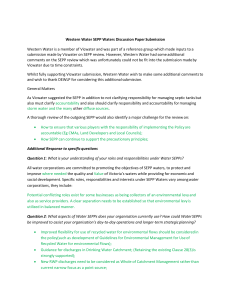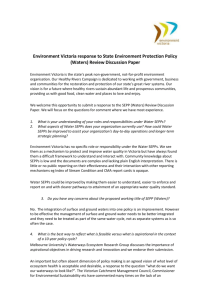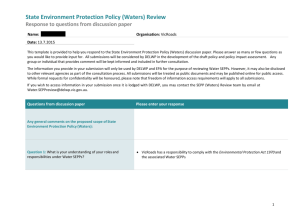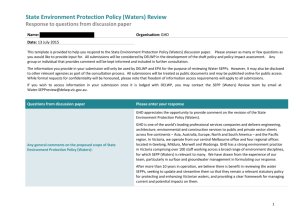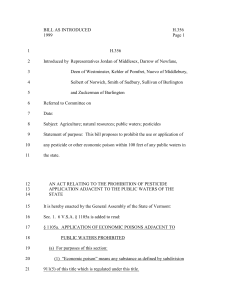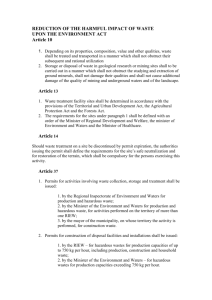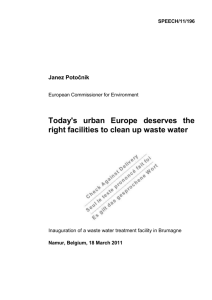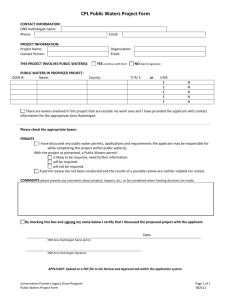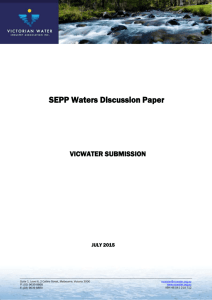South East Water (Accessible version)
advertisement
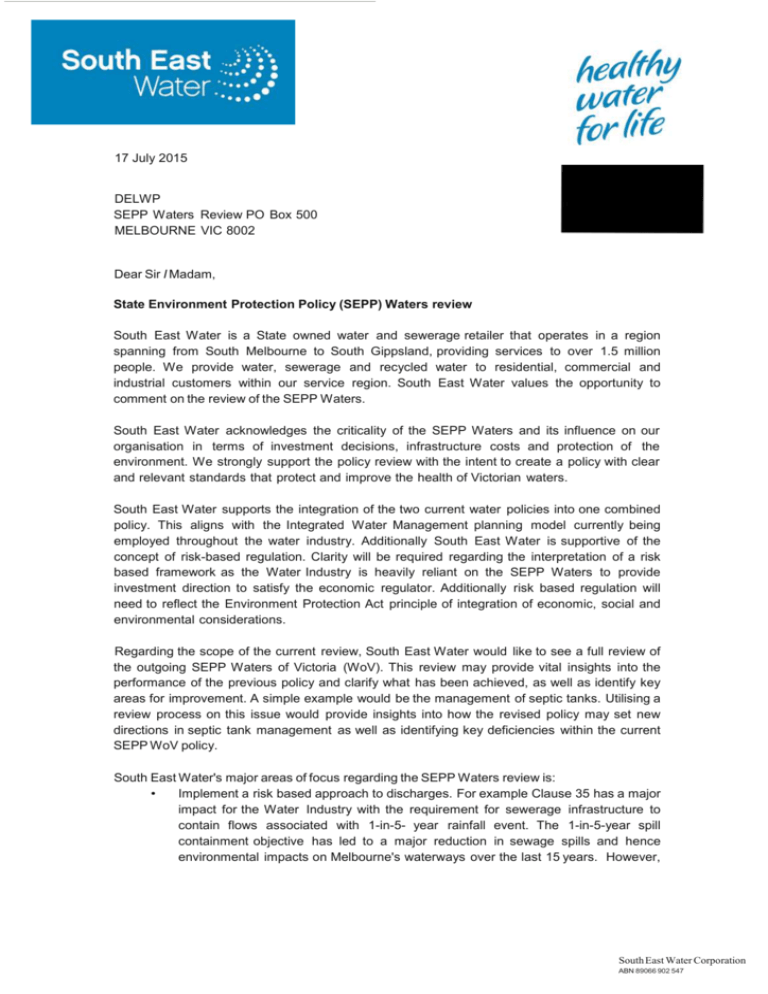
17 July 2015 17 July 2015 DELWP SEPP Waters Review PO Box 500 MELBOURNE VIC 8002 Dear Sir I Madam, State Environment Protection Policy (SEPP) Waters review South East Water is a State owned water and sewerage retailer that operates in a region spanning from South Melbourne to South Gippsland, providing services to over 1.5 million people. We provide water, sewerage and recycled water to residential, commercial and industrial customers within our service region. South East Water values the opportunity to comment on the review of the SEPP Waters. South East Water acknowledges the criticality of the SEPP Waters and its influence on our organisation in terms of investment decisions, infrastructure costs and protection of the environment. We strongly support the policy review with the intent to create a policy with clear and relevant standards that protect and improve the health of Victorian waters. South East Water supports the integration of the two current water policies into one combined policy. This aligns with the Integrated Water Management planning model currently being employed throughout the water industry. Additionally South East Water is supportive of the concept of risk-based regulation. Clarity will be required regarding the interpretation of a risk based framework as the Water Industry is heavily reliant on the SEPP Waters to provide investment direction to satisfy the economic regulator. Additionally risk based regulation will need to reflect the Environment Protection Act principle of integration of economic, social and environmental considerations. Regarding the scope of the current review, South East Water would like to see a full review of the outgoing SEPP Waters of Victoria (WoV). This review may provide vital insights into the performance of the previous policy and clarify what has been achieved, as well as identify key areas for improvement. A simple example would be the management of septic tanks. Utilising a review process on this issue would provide insights into how the revised policy may set new directions in septic tank management as well as identifying key deficiencies within the current SEPP WoV policy. South East Water's major areas of focus regarding the SEPP Waters review is: • Implement a risk based approach to discharges. For example Clause 35 has a major impact for the Water Industry with the requirement for sewerage infrastructure to contain flows associated with 1-in-5- year rainfall event. The 1-in-5-year spill containment objective has led to a major reduction in sewage spills and hence environmental impacts on Melbourne's waterways over the last 15 years. However, South East Water Corporation ABN 89066 902 547 .·:--:- .::·.··. • • • • there is a need to consider a more flexible approach for situations where the cost effectiveness of achieving the containment objective is doubtful and more significant local benefits could be achieved using a different approach, for example a 1-in-10 year containment for highly sensitive areas or an offset approach. Providing clarity in the interpretation of defining and protecting beneficial uses. As outlined in the response to discussion paper South East Water supports a review of the beneficial uses and proposes the possibility of utilising a hierarchical framework that is reflective of the current Planning and Environment Act . Each category would work similar to how the Planning and Environment Act schedules of zones divide up the Land Uses into "Permit not required", "Permit required" and "Prohibited". Implementing an innovative approach to the water quality management within the catchment as opposed to direct point source pollution. For example the management response to discharge from farming land could be reviewed in order to reduce the diffuse pollution sources within the catchment Creating a flexible policy that allows for innovative wastewater management solutions for new treatment plants. As discussed in the discussion paper response document, current clauses have limitations and significant cost implications. Additionally remove the clause requiring to continuously reduce the mixing zone through complete elimination of discharge. There will be cases where no further continual improvement is warranted from a community cost/benefit analysis. Finally South East Water strongly supports the focus on diffuse pollution sources. There has been significant emphasis placed on licensed point source pollution as opposed to the totality of diffuse source pollution. Greater community/environmental benefit could be achieved by addressing the cumulative impact of diffuse source pollution. The historical focus on point source discharges appears to have achieved a significant benefit and further emphasis may lead to significant community costs with minimal environmental benefit. If you require further information in relation to South East Water's response, please contact. South East Water South East Water Corporation ABN 89066 902 547 State Environment Protection Policy (Waters) Review Response to questions from discussion paper Name: Organisation: South East Water Date: 17 July 2015 This template is provided to help you respond to the State Environment Protection Policy (Waters) discussion paper. Please answer as many or few questions as you would like to provide input for. All submissions will be considered by DELWP in the development of the draft policy and policy impact assessment. Any group or individual that provides comment will be kept informed and included in further consultation. The information you provide in your submission will only be used by DELWP and EPA for the purpose of reviewing Water SEPPs. However, it may also be disclosed to other relevant agencies as part of the consultation process. All submissions will be treated as public documents and may be published online for public access. While formal requests for confidentiality will be honoured, please note that freedom of information access requirements will apply to all submissions. If you wish to access information in your submission once it is lodged with DELWP, you may contact the SEPP (Waters) Review team by email at Water.SEPPreview@delwp.vic.gov.au. Questions from discussion paper Please enter your response 1 State Environment Protection Policy (Waters) Review Response to questions from discussion paper SE Water acknowledges the criticality of the SEPP Waters and its influence on our organisation in terms of investment decisions, infrastructure costs and protection of the environment. We strongly support the policy review with the intent to create a policy clear and relevant standards and legal obligations to protect and improve the health of Victorian waters. Any general comments on the proposed scope of State Environment Protection Policy (Waters): Regarding the scope of this review, SE Water would like to see a full review of the outgoing SEPP Waters of Victoria (WoV). This review may provide vital insights into the performance of the previous policy and clarify what has been achieved as well as identifying key areas for improvement. A simple example would be the management of septic tanks. Utilising a review process on this issue would provide insights into how the revised policy may set new directions in septic tank management as well as identifying key deficiencies within the current SEPP WoV policy. Additionally there appears to be a lack of enforcement/accountability on the implementation of the previous SEPP WoV. Again SE Water sees the implementation of the SEPP Waters as a critical element to ensure a constructive policy is developed. SE Water supports the integration of the two current water policies into one combined policy. This aligns with the Integrated Water Management planning model currently being employed throughout the Water Industry. Additionally, SE Water is supportive of the concept of riskbased regulation to deliver community value. Clarity will be required regarding the interpretation of a risk based framework as the Water Industry is heavily reliant on the SEPP Waters to provide investment direction to satisfy the economic regulator. Finally SE Water strongly supports the focus on diffuse pollution sources as significant emphasis has been placed on licensed point source pollution as opposed to the totality of diffuse source pollution. Greater community/environmental benefit could be achieved by addressing the cumulative impact of diffuse pollution. The historical focus in this area appears to have achieved a significant benefit in improving point source discharges and further emphasis may lead to significant community costs with minimal environmental benefit. 2 State Environment Protection Policy (Waters) Review Response to questions from discussion paper Question 1: What is your understanding of your roles and responsibilities under Water SEPPs? The role of the SEPP is to articulate the standards required to protect the beneficial uses for the variety of water environments and establish a framework to achieve those standards where they are currently not being met. Key areas for SE Water are; • Licensed wastewater discharges and building treatment plants to the specified standards • Articulating the beneficial uses for waters that are valued by our customers • Not to pollute/impact on the beneficial uses • Progressively reduce the mixing zones • Minimise wastewater losses and design to 1-in-5 containment standard • Conserve and recycle water • Provide reticulated sewerage infrastructure 3 State Environment Protection Policy (Waters) Review Response to questions from discussion paper How could Water SEPPs be improved to assist your organisation’s day-to-day operations and longer-term strategic planning? SE Water interacts with the SEPP in the following ways; • Licensed discharges to the environment – the requirement to enforce standards for 100% reuse are proving to be costly when a whole of catchment approach (e.g. offset) could deliver a better community/environmental outcome. • Sewerage management – Clause 35 is a critical clause that is quite descriptive as opposed to other clauses that are open to interpretation. SE Water would support a risk-based approach that incorporates the principle of integration of economic, social and environmental considerations. • Domestic Wastewater Management – providing reticulated sewerage to the community. Lack of accountability in this area by local government has previously been stated. • Integrated Water Cycle Management and its relationship with waterway health and associated targets. • Offsets – SE Water supports the concept of offsets but is unclear as to how to apply the framework to achieve a successful outcome. • Dewatering activities – SE Water is often involved with developers that require a discharge to sewer due to the contamination of groundwater. The issue is that quite often the saline groundwater detrimentally impacts on the opportunity for recycling as well as the biological treatment processes. The combination of the SEPPs will ideally address this issue allowing a whole of water cycle management approach to be incorporated. • Groundwater management – Avoiding contamination of groundwater from seepage of contaminated water from assets and increasing pressures around aquifer recharge opportunities to expand recycled water/stormwater use. Question 3: Do you have any concerns about the proposed working title of State Environment Protection Policy (Waters)? If so, what are they? We support the title as well as the combination of the two policies. Question 2: What aspects of Water SEPPs does your organisation currently use? 4 State Environment Protection Policy (Waters) Review Response to questions from discussion paper Question 4: What is the best way to reflect what is feasible versus what is aspirational in the context of a 10-year policy cycle? Question 5: Do you support the proposed SEPP (Waters) objective of “this policy is to protect and improve the quality of Victoria’s waters while providing for economic and social development”? Why? Question 6: Do you support the need to balance economic and social development with overall protection and improvement of water quality for Victoria’s water environments? Why? SE Water supports a policy that sets measurable targets for compliance. There has always been confusion on whether the attainment standard is aspirational or feasible? There is a beneficial use of King Parrot Creek in Longwarry for potable drinking water. SE Water provide reticulated water to Longwarry so do not see this aspirational requirement as realistic or valuable. The policy should articulate the agreed objectives that are achievable within the timeframe. This would then allow for continued monitoring against the target rather than an arbitrary standard that may never be achieved within the 10 year timeframe. South East water recommends a framework be developed to ensure what is defined as feasible can actually be delivered. SE Water supports the objective to protect and improve the quality of Victoria’s waters. We also acknowledge the need to account for the economic and social values. Therefore the policy should be striving to protect and enhance the beneficial uses of Victoria’s Waters rather than enhance the quality. The ‘natural’ quality of water is variable and defining ‘clean’ for every waterway will be difficult. Also the range of beneficial uses a waterway has and the quality of that use should be the measure of a good waters. SE Water strongly supports the need to balance economic and social development whilst protecting water quality. We believe that this is an opportunity to be innovative in how water quality is protected e.g.: investing in best community/environmental outcomes. 5 State Environment Protection Policy (Waters) Review Response to questions from discussion paper Question 7: What are the challenges of balancing economic and social development with protecting and improving water quality? How should we manage the appropriate trade-offs between them? Question 8: Do you foresee any problems or opportunities that may arise from creating one consistent SEPP to apply to all Victorian waters? Are there other options for streamlining the policies that we should consider? Question 9: Are there any specific types of water environments, for example, a wastewater treatment lagoon, where you think beneficial uses should not be protected? Question 10: Do you think the current measures for classifying surface water and groundwater segments are still appropriate? Are there other measures that should be explored? A key flaw with the current SEPP WoV is the ineffectiveness to balance economic, social and environmental objectives. Historically point source pollution has been the focus for the environmental regulator where as a risk based approach to whole of catchment management would see the pendulum swing to a more balanced approach. Additionally a lack of accountability for diffuse source pollution (e.g. nutrient farm runoff) has enhanced the lack of balance. South East Water suggests cost/benefit analysis to identify best area for improvement with the costs shared by all those who contribute to the impacts? The revised SEPP Waters will need to include greater accountability for roles and responsibilities whilst ensuring the regulator has clarity in terms of effective regulation. SE Water supports the concept of creating one consistent policy for Victorian waters. The area of clarity we would require would be how to balance conflicting requirements that sit outside water quality; for e.g. achieving higher treatment quality at the expense of increased energy consumption/GHG emissions? A TBL framework to be developed to incorporate externalities eg: cost of carbon. SE Water believes that assets associated with the treatment process should not be protected for beneficial uses as this may impede the appetite to optimise environmental performance due to a perverse outcome. A mechanism needs to be created to enable new and existing waters to be given special case by case considerations. As it is fundamentally impossible to list every current waterway within which beneficial uses don’t need to be protected. For example we may look to create a wetland for additional treatment prior to discharge and over time will be required to desilt the wetland. If it is protected under beneficial uses we may not pursue this opportunity. SE Water would like to see further investigation into protecting segments. For example TDS appears to be a crude starting point for protecting particular beneficial uses in regards to groundwater. On the Mornington Peninsula SE Water supplies potable water but the groundwater is protected as a beneficial use for drinking purposes due to its low TDS. We understand the value of protecting the groundwater, however not because it falls into a category due to salt concentrations. 6 State Environment Protection Policy (Waters) Review Response to questions from discussion paper Question 11: Are there any problems with the spatial arrangements or segment boundaries in the existing Water SEPPs? If so, what are they? Question 12: What do you think are the advantages or problems with the new approach to segments and sub-segments? The SEPP as a communication tool is requires vast improvement. There is a huge opportunity to bring this policy document in 2015 by developing a document that clearly articulates your location and the water quality attainment standards required at the point. A GIS interactive online system would be ideal. The GIS system (Planning Maps on line) and legislation links that are associated with the Planning and Environment Act are a good minimum standard for consideration SE Water supports the concept of sub segments as a way to acknowledge natural water quality variability in certain areas. It is also an opportunity to align with local catchment strategies that have articulated the information required at a local level. The key consideration required is to be able to introduce a TBL risk-based framework whilst quantifying local attainment standards within a segment. Question 13: Are there any features of the landscape that you would like to see as a standalone segment or sub-segment? Not currently. Question 14: Do you believe that all beneficial uses set out in Table 2 of the discussion paper should still be protected under the new SEPP (Waters)? Where do you think a beneficial use would not apply? Why? SE Water supports the beneficial uses set out in Table 2. However, a detailed review of the beneficial uses is required to ground truth the fact that they are actual beneficial uses and not aspirational goals that do not reflect community standards. Question 15: What method or approach could be used to apply the beneficial uses to segments and sub-segments? As has been stated numerously a move towards a risk-based approach would see the introduction of Ecological Risk Assessment as the method to ensure the beneficial uses are protected within each segment. Another approach could be the implementation of a hierarchical framework for the protection of beneficial uses. This is explained further in the additional comments sections. 7 State Environment Protection Policy (Waters) Review Response to questions from discussion paper Question 16: Are there any additional beneficial uses that you believe should be protected? Are there any that you think should no longer be protected? Why? Question 17: What do you think about the current indicators, the approach for deriving objectives and the proposed changes? Question 18: How have nutrient load targets been useful in driving environmental investment outcomes? Would you like to see a different approach, and if so, what might that be? Question 19: What is the preferred method for management of at-risk areas? Are there activities that need greater intervention or regulation? What would the intervention be, for example, voluntary or mandatory codes of practice, regulation via licensing? SE Water sees this as an opportunity to redefine the beneficial uses in such a way that they contribute to a risk-based approach in protecting water quality. A robust community engagement program would support this approach. Additional Beneficial Uses of Waters: - Treatment of wastes (for example the wetland raised earlier) - Drainage of land (Channels) SE Water’s experience is that where there are indicators it provides a logical starting point to undertake a water quality assessment. The issue is that a number of potentially harmful parameters do not have indicators/limits and therefore it is difficult to make any judgement calls e.g. pharmaceuticals. We do support any alignment with national standards where they exist and would prefer them to be documented in the SEPP Waters policy but understand the limitations in referring to other policies. Additionally a transparent approach in setting the indicators needs to be articulated in order for all to understand how certain standards have been derived. Having clear targets with responsible agencies assists in driving improved environmental performance e.g.: reduction of Nitrogen in Port Phillip Bay. If nutrient loads are to be introduced it would need to be implemented at a catchment scale with transparent methodology for accounting purposes within and across catchment boundaries. Concentrations in waterways can also be an important indicator rather than just the actual loads in the receiving environment. Additionally other critical parameters that impact on beneficial uses need to be considered eg Suspended solids, Ammonia, etc. SE Water recognises that diffuse pollution is one of the most significant water quality problems. In terms of addressing at risk areas, SE Water supports the SEPP Waters renewed focus in this area. Setting environmental standards at a regional scale with ongoing monitoring to identify breaches of trigger values would greatly assist in improving water quality standards. Obviously resources would be required to ensure the policy standards are being adhered to. EPA have a compliance and enforcement policy that clearly articulates the level of enforcement applied in relation to the culpability and risk to environment. This policy has varying levels of intervention. 8 State Environment Protection Policy (Waters) Review Response to questions from discussion paper Question 20: What do you think the role of SEPP (Waters) should be in identifying and filling knowledge gaps over the life of the policy? How can we assure an adaptive approach within SEPP (Waters)? As stated SE Water acknowledges the value of the SEPP Waters and strongly supports the policy to set clear objectives and targets that deliver catchment wide benefits. It is critical that the revised SEPP not only sets the targets for water protection but also identifies the key threats to water quality and acknowledges processes to address these threats. This would be supported by enforcing the roles and responsibilities that are outlined within the policy and ensure they are adequately resourced to deliver the desired outcomes. • • Any other information you would like to share: • • The interaction between competing environmental risks is not addressed in the discussion paper. For example the energy intensive process to achieve high quality water to discharge into waterways verses CO2 emissions and its impact on climate change. Additionally adapting to future climate change doesn’t appear to be built into the discussion paper. eg. Ensuring a greater than 1-in-5 containment standard applied in highly sensitive areas. The management of dewatering from construction projects that is not fit to discharge into waterways only leaves the option to discharge to sewer. A big issues arises when the contamination is primarily saline and hence significant impacts on producing recycled water. The SEPP Waters outcomes should be consistent with the upcoming development of the State Water Plan (broad government policy – with Climate Change at forefront) and upcoming Central Region Sustainable Water Strategy (2016) Regarding Whole of Water Cycle Management, SE Water could well be a significant recycler of stormwater services in the future. We have a current pilot project running at Troupes Creek. This raises a different perspective of pollution within the catchment. In this case a very local catchment fed by stormwater events and subject to all types of pollution – far different from the potable catchment / groundwater type issues Hierarchy of Beneficial Uses: See below Table 9 State Environment Protection Policy (Waters) Review Response to questions from discussion paper Hierarchy of Beneficial Uses Key Concepts: - The long list of Beneficial Uses should be allocated into categories that reflect priority for protection. - Each defined segment could potentially have a unique suite of Beneficial Uses - Similar to how Zones in the Planning and Environment Act have Land Uses allocated to either “Permit not required”, “Permit Required” and “Prohibited” categories. These key concepts would address inconsistencies in the current SEPP. - For instance the long list of existing Beneficial Uses contains conflicts regarding which uses have primacy. For example: o Primary/Secondary Contact Recreation and Human consumption. Having recreational activities on a waters will increase the need of treatment before human consumption. o Fish, crustacean and molluscs for human consumption and Aquatic ecosystems. Human consumption of biota puts pressure on the survival of Aquatic ecosystems Furthermore these concepts would: - Support the simplification of the current segments as proposed in the discussion paper in section 2.3. For example Coastal National Parks are created from the general coastal areas to ensure the protection ecosystems. - Communicate the difference between ‘Aspirational’ and ‘feasible’ targets. - Enable a systematic approach to rolling out improvements in waters over the 10 year life of the policy. 10
